The day started off great on the bay. The night ended with me and my father freezing cold in a thick fog with barely any working navigational electronics before running the boat aground in my own slip in the marina where I keep her. If you're up for a somewhat painful story about a good trip turned bad, read on...
We got underway around noon from Alameda. As we were leaving the berth at the boatyard, we passed another Islander Pacific 41' like mine only not as pretty:

On our way out of the Oakland Estuary, we were keeping pace with this snazzy little motoryacht:
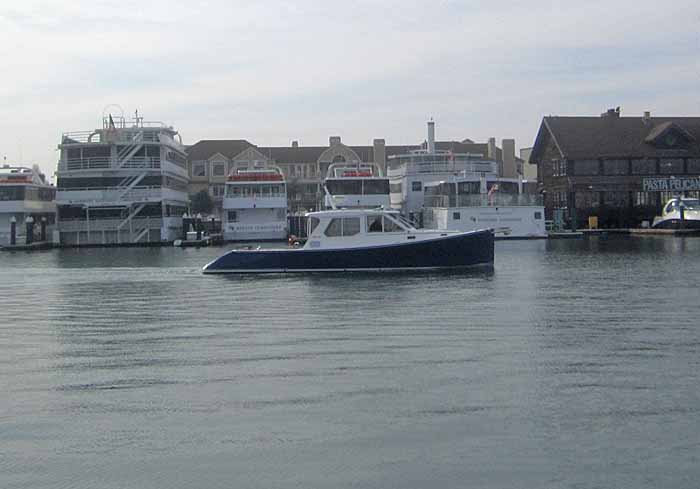
As we were heading out, I noticed that the depth sounder wasn't working. This will become relevant later.
Clear of the channel, we hoisted the sails and did a bit of tacking back and forth south of Yerba Buena Island just to make sure the rigging was all in good order. The wind was going exactly the wrong direction for the transit North, so we cheated a bit and motored under the eastern side of the Bay Bridge:
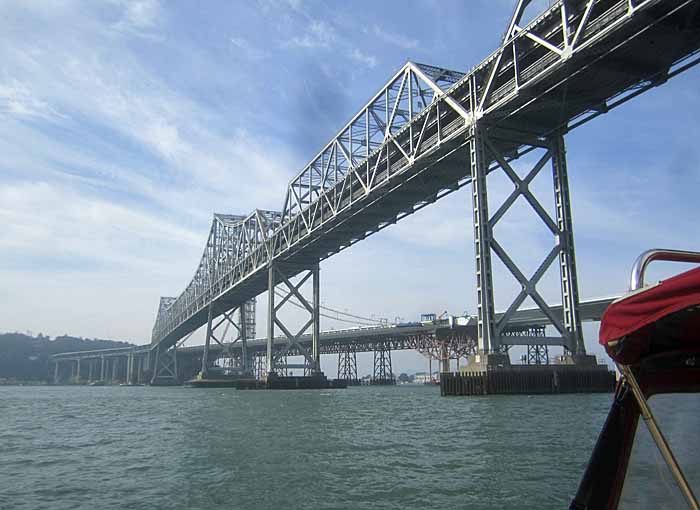
I know there's plenty of room for my little boat to fit under this bridge, but I still find myself getting nervous when I pass under bridges now. It doesn't help that the perspective always tricks you into thinking the mast is going to touch:

Once we were clear of the bridge and past the lee side of Treasure Island, I killed the engine so we could finally enjoy a bit of proper sailing. It was only a couple of hours worth of beating into the wind, but I can't tell you how happy I was to finally have my boat back.
As we made our way north, the wind slacked off and the current picked up. Eventually it was all we could do to hold our position against the current. Before too long I had to admit defeat, point straight into the wind, furl the sails, and proceed under power. Here's a quick shot of the Golden Gate fading into the mist behind us:
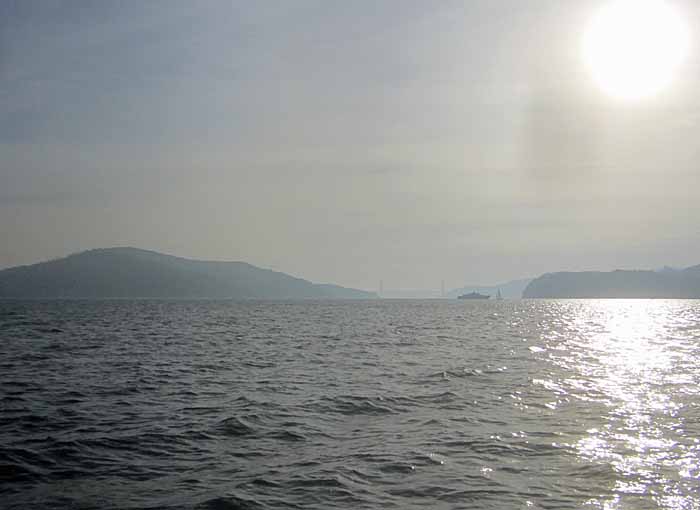
Passing Red Rock:

Dad spent most of the day bundled up in the cockpit and hanging out:
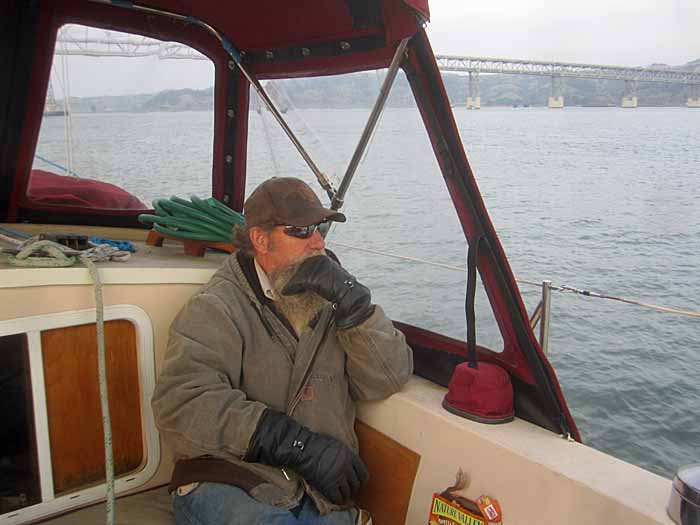
Meanwhile, I got another chance to exorcise my bridge clearance paranoia under the San Rafael-Richmond Bridge:
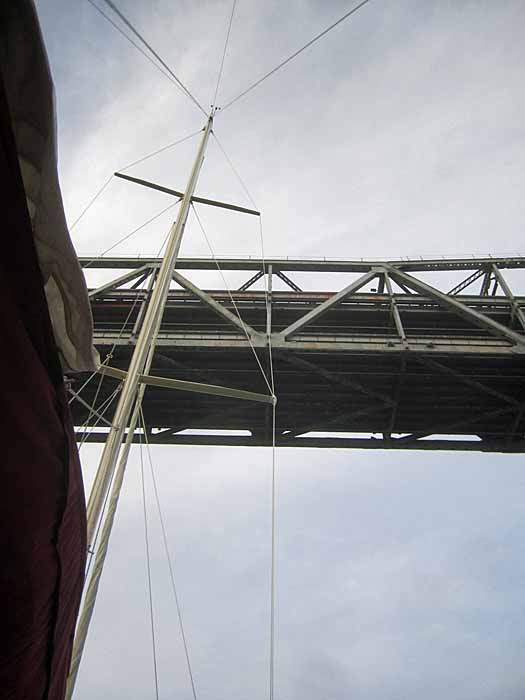
As we passed marker six, I snapped a pic showing the wake from the current rushing past the buoy:
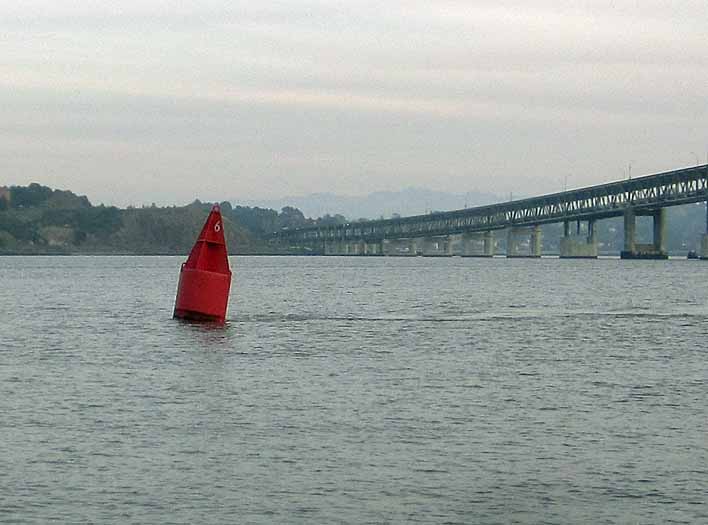
It was slow going across San Pablo Bay on the way to the Petaluma River Entrance Channel. We reached the first daymarker just after the sun had set:

The channel transit was pretty uneventful. It wasn't until we passed under the Highway 37 causeway bridge at Black Point that things started getting interesting. Suddenly the fog started to close in and visibility dropped to about 100 yards. Unable to see the river ahead, I had to steer by gauging the distance to the bank on either side as we headed up the river.
Earlier in the year, a sailboat sank about halfway up the river in the middle of the channel by the tiny community of Lakeville. As luck would have it, visibility opened up and the tide was so low that we had no time spotting the mostly submerged wreck and avoiding it. To make it even easier, someone in a parking lot ashore had left their headlights on and they were pointed right at the mast of the sunken boat. Thank you, whoever you were.
After clearing Lakeville, things got much worse. The trickiest part of the upper Petaluma River transit is a turn called Cloudy Bend. At high tide the river looks to be almost 200 feet wide at this point, but there's only about 80 feet of that width that's deep enough to transit. The rest is only about knee deep at high tide. At low tide, it's a huge peninsula of soft mud. If there was any place we'd get stuck, that was it.
As we were coming up on the turn, I slowed to about 1.5 knots and started to favor the left bank of the river to give the shallow part as wide of a berth as possible. As we were making the turn, the fog thickened. There are two buoys that mark the edge of the shallow at Cloudy Bend. We only saw one of them even though we had to have passed within about fifteen feet of the second one.
Once I was confident that we were clear of the shallows, I picked up speed again. Just as I was remarking about how we'd gotten through the worst of it, the boat ran aground. I never even saw the bank where we touched bottom even though you could reach out and touch it from the deck. As I backed off, the rudder got stuck in the mud astern. In the darkness and fog, there was no frame of reference to tell when I finally started creeping forward again, so just when I noticed that I'd gotten headway again, I managed to slide right back into the mud ahead. The tide was so low that the boat barely fit in the river sideways. I ended up going back and forth this way three or four times before finally getting the boat turned enough to clear the banks on both sides.
That's when I looked down at the compass and realized that I'd somehow gotten us turned around and headed back downriver. If it was happening to someone else, I'd've been laughing at them.
After a bit more grounding and turning and grounding and turning around, I got us pointed back in the right direction. Proceeding blindly upriver, I'd slowed to a crawl to avoid doing any damage in case we grounded again.
We did. I don't remember how many times I managed to touch bottom, but the saving grace is that the bottom of the river is soft mud almost everywhere. Since Dad and I both know the river pretty well, I was confident that we could make the rest of the transit while avoiding the few places where there were rocks or structures along the banks. Still, the last half mile or so worth of the passage took nearly two hours as we crept along.
As we headed upriver, we kept looking out for any of the lights that should've been visible ahead. Even a hint of a glow would've been useful. We could hear the traffic on Highway 101 to the west, but never saw any of the lights ashore until we were at the entrance to the Petaluma Marina.
That should've been the point where I was home free, but the City of Petaluma has neglected the Marina for a number of years and the silt has made it much shallower than it's advertised depth of ten feet. As we were passing C Dock in the middle of the marina, right in the middle of the fairway, I ran aground again. Cranking up the throttle, I was able to force my way through the mud to my berth.
Once we were close enough to reach the dock, dad put a bow line around a cleat and I tried to spring the stern in. Even with the engine running full speed ahead there was no moving. I was aground in my own home berth where the boat has been moored most days and nights for the past four years.
Having arrived alive, we counted our blessings, passed the rest of the mooring lines over to the dock, and headed home. That was just after 2330.
At about 0130 I came back. The tide had risen slightly so I could pull the stern in and tie the boat securely alongside the dock.
Taken for all in all, I'd call it a successful shakedown cruise. Now I just need to troubleshoot the depth sounder and replace the radar so we can avoid these problems in the future. I'm done with navigation by the Braille method.

No comments:
Post a Comment